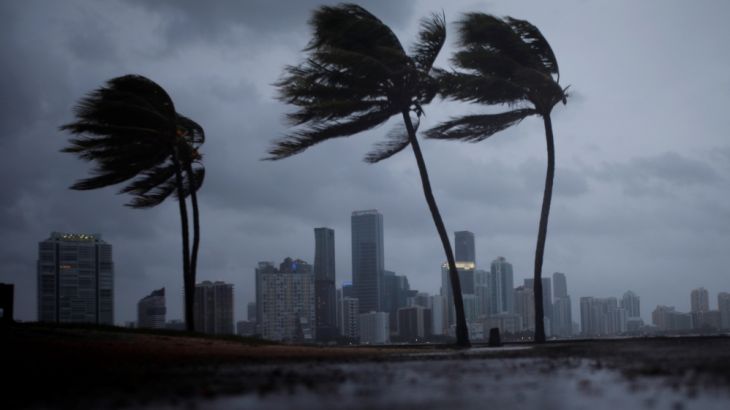Florida braces for Hurricane Irma after Cuba landfall
Powerful storm strikes Cuba’s Camaguey Archipelago as millions of Florida residents scramble to evacuate coastal areas.

Strong winds and heavy rain have reached the coast of Florida as the centre of Hurricane Irma moved closer to the US state.
Millions of residents were ordered to evacuate on Saturday after the powerful storm killed at least 25 people in the eastern Caribbean and left destruction in its wake.
Keep reading
list of 4 itemsPhotos: Athens turns orange under North Africa’s Sahara dust clouds
100,000 people evacuated from China flood zone
Asia bears biggest climate-change brunt amid extreme weather: WMO
Irma made landfall as a Category 5 storm in Camaguey Archipelago on Cuba’s north-central Atlantic coast packing 260 kilometres per hour winds late on Friday, the National Hurricane Center (NHC) said.
Category 5 is the NHC’s most powerful designation.
|
|
One of the fiercest Atlantic storms in a century, Irma weakened on Saturday to Category 4 and then to a Category 3, packing 205km/h winds.
It was expected to strengthen again before hitting Florida on Sunday morning, bringing massive damage from wind and flooding to the fourth-largest US state by population.
The scenes along Cuba’s coast were gradually coming to resemble horrors of other Caribbean islands over the last week as Irma barreled in for a direct hit at Ciego de Avila province around midnight.
Al Jazeera’s Julia Galiano, reporting from Cuba’s capital, Havana, said it would take several hours to assess the extent of damages in the country while the storm makes the expected right turn, heading towards Florida.
![Residents head into a shelter in Estero, Florida, ahead of the arrival of Hurricane Irma [Adrees Latif/Reuters]](/wp-content/uploads/2017/09/241f98ba1dd044dc95d61562acff0732_18.jpeg)
“Cuban officials said this morning that one million residents had been evacuated ahead of the storm,” Galiano said.
“Cuba has a very well-functioning system when it comes to preparedness for these kinds of disasters, which results in much lower numbers of victims compared with the rest of the region.”
‘Running out of time’
The United States has been hit by only three Category 5 storms since 1851, and Irma is far larger than the last one in 1992, Hurricane Andrew, according to the Federal Emergency Management Agency (FEMA).
“We are running out of time. If you are in an evacuation zone, you need to go now. This is a catastrophic storm like our state has never seen,” Governor Rick Scott told reporters, adding the effects would be felt from coast to coast in the state.
More than 170,000 homes and businesses were without power late on Saturday as the approaching storm unleashed winds and rains on the state. More outages were expected as Irma moved closer to Florida.
READ MORE: Deaths and destruction as Hurricane Irma powers through
Al Jazeera’s Alan Fisher, reporting from Miami, said the city remained relatively quiet as a curfew went into effect in cities across the state.
“The storm surge that is coming is going to be the big worry,” Fisher said.
“It could be two to three metres, which could mean significant flooding and damage to homes.”
The National Hurricane Center warned the storm surge in some areas could be as high at 4.6 metres. It said the surge flooding could cause “life threatening” conditions throughout central and southern Florida.
|
|
A total of 5.6 million people, or 25 percent of the state’s population, were ordered to evacuate Florida, said the Florida Division of Emergency Management.
US President Donald Trump said in a videotaped statement that Irma was “a storm of absolutely historic destructive potential” and called on people to heed recommendations from government officials and law enforcement.
FEMA on full alert
Irma was set to hit the US two weeks after Hurricane Harvey, a powerful Category 4 storm, struck Texas, killing about 60 people and causing property damage estimated at up to $180bn in Texas and Louisiana.
|
|
Officials were preparing a massive response, the head of FEMA said.
About nine million people in Florida may lose power, some for weeks, said Florida Power & Light Co, which serves almost half of the state’s 20.6 million residents.
Amid the exodus, nearly one-third of all petrol stations in Florida’s metropolitan areas were out of petrol, with scattered outages in Georgia, North Carolina and South Carolina, according to Gasbuddy.com, a retail fuel price tracking service.
READ MORE: Irma heads to Florida, kills 22 across Caribbean
As it roared in from the east, Irma ravaged small islands in the Caribbean, flattening homes and hospitals and ripping down trees.
At least 25 people have died so far, according to an AFP news agency count: 10 in the French islands of Saint Martin and Saint Barthelemy, six in British overseas territories, four in the US Virgin Islands, two in Puerto Rico and two in the Dutch part of Saint Martin and one in Barbuda.
Saint Martin – “Sint Maarten” in Dutch – is divided between France and the Netherlands.
The International Red Cross says 1.2 million people have already been affected by Irma – a number that could rise to 26 million.
The bill for loss and damage could hit $120bn in the US and Caribbean, according to data modelling firm Enki Research.
Irma (left, Cat 5) and Jose (right, just upgraded to Cat 3)
Simultaneous major hurricanes for the first time in seven years. pic.twitter.com/qDstJtUDE7— Eric Holthaus (@EricHolthaus) September 7, 2017
Residents of the islands face the threat of another major storm, Hurricane Jose.
Jose, expected to reach the northeastern Caribbean on Saturday, was an extremely dangerous storm nearing Category 5 status, with winds of up to 250km/h, the NHC said on Friday.